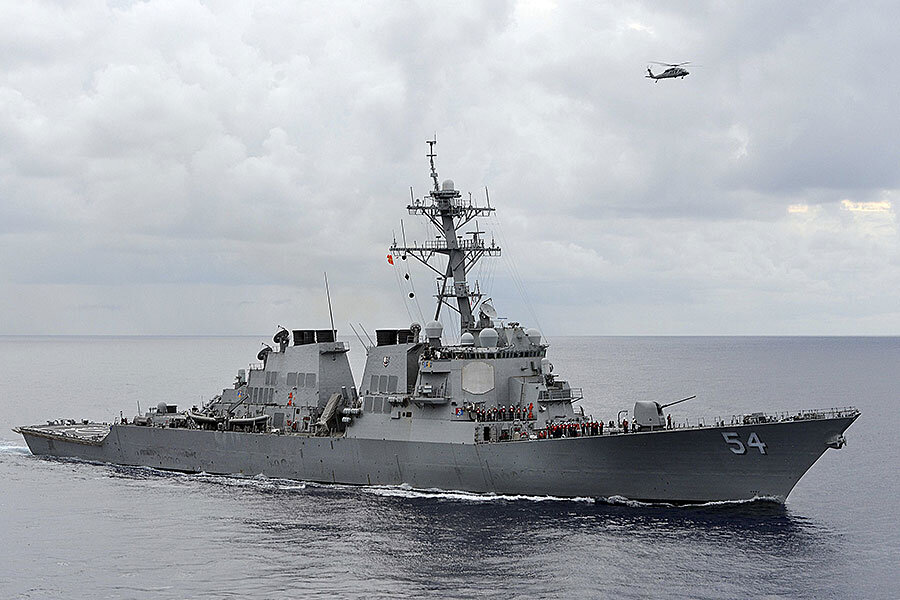US warship challenges China. What's the South China Sea strategy?
Loading...
A US naval ship conducted a patrol Saturday around a disputed island in the South China Sea, in the second such maneuver in recent months.
The island is one of many in the area subject to competing claims, in a saga that has raised tensions between China and its neighbors.
The United States also has an interest in the region, not only because of its complex relationship with China, but also because the waters represent a key trade route for global shipping.
So this maritime patrol, which centered on Triton Island, is part of the US strategy to ease tensions and weave a precarious path between provoking China and ensuring Beijing abides by international norms.
“The excessive claims regarding Triton Island are inconsistent with international law as reflected in the Law of the Sea Convention,” said a US Department of Defense statement.
Tensions in the South China Sea have been rising, as China compounds the conflicting claims by beginning a program of building on some of the contested outcrops, including the laying down of airstrips capable of receiving military aircraft, according to analysts.
“The worry is that China is steadily expanding its presence until its dominance of the sea becomes an incontestable fact,” notes the Economist.
The United States, among other nations, takes exception to this.
“The U.S. government takes no position on the territorial disputes in the Spratly Islands, but does take a strong position on what kinds of claims are made to the waters surrounding those features,” states an analysis by the Center for Strategic and International Studies (CSIS).
In addition, this situation forms part of the wider picture of China’s gradual rise as a world power, and the only credible challenger to US hegemony. The US also has many allies in the region, some covered by defense treaties, and any escalation of tension would likely require a response by the US.
But the path appears narrow that steers towards a peaceful outcome, and the last thing President Barack Obama wants, particularly in his final year in office, is to provoke a major confrontation with China.
In fact, prior to the first of these patrols, which took place last October, the Pentagon was ready for months to take action, but ran into “repeated stalling” from the White House and State Department, according to Reuters.
“The concern was that, if we looked like we were responding to something the Chinese had done, it would undermine our assertion that this is a matter of international law, and our rights to navigate the seas,” said a US Defense Department official.
Thus, the US strategy now. The aim, in undertaking these naval patrols, is to assert “freedom of navigation” (FON), “to ensure that U.S. naval, coast guard, and civilian ships, and by extension those of all nations, maintain unrestricted access to their rights at sea," while doing so in such a manner that averts military conflict with China, explain Michael J. Green, Bonnie S. Glaser, and Gregory B. Poling in an article for the CSIS.
“China's sabre-rattling generals would have us believe that their president, Xi Jinping, is so unhinged that he would risk nuclear Armageddon to preserve his country's nationalistic pride in the South China Sea,” wrote John Garnaut in The Age.
“They promised to strike a 'head-on blow' at any foreign vessel that challenged China's territorial virility by sailing close to the five artificial islands that Xi has been dredging into existence off the Philippines coast.”
This goes some way to explain Obama’s caution before he first tested the waters, last October. In the event, however, China gave little public reaction, simply issuing a condemnation of the action via its national news agency, Xinhua.
The latest US incursion into disputed waters, around Triton Island, has so far elicited only mild censure via Xinhua, with a Beijing defense ministry spokesman quoted as saying, “the U.S. act severely violated Chinese law, sabotaged the peace, security and good order of the waters, and undermined the region' s peace and stability”, adding that the Defense Ministry is “firmly against this”.
Yet perhaps, once again, the muted reaction is a dividend of the careful US approach, relaying to China that the United States will counter excessive territorial claims, but in such a way as to minimise the risk of direct confrontation.
“The choice of Triton may have been influenced by the relatively lower operational risk than, say, Mischief Reef (in the Spratly archipelago), which many were expecting would be the location for the next FONOP,” said Euan Graham, director of the International Security Program at the Lowy Institute in Sydney, according to The Japan Times.
The United States has been here before. In recent years, the Chinese pushed hard to challenge Japan’s administration of the Senkaku, or Diaoyu islands, but, as noted by John Garnaut in The Age, they appeared to finally desist when it became clear that Japan Prime Minister Shinzo Abe and Obama would only tolerate so much.
“[Chinese leader] Xi's PLA [People’s Liberation Army] will push, and it will bluster, but it will stop at the point at which it meets credible resistance,” writes Garnaut. “Contrary to what we've been led to believe, Xi is not interested in risking everything against the military might of the United States.”






